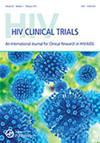HIV病毒动力学和T细胞动力学在抗逆转录病毒naïve人开始整合酶链转移抑制剂和蛋白酶抑制剂方案
Q2 Medicine
引用次数: 2
摘要
背景:保留核苷酸逆转录酶抑制剂(NRTI)的方案可能会最大限度地减少抗逆转录病毒(ART)的毒性,但疗效和毒性结果参差不齐。整合酶链转移抑制剂(INSTI)和蛋白酶抑制剂(PI)方案对HIV病毒动力学和T细胞动力学的影响尚不清楚。目的:比较雷替拉韦+利托那韦增强洛匹那韦(RAL+LPV/r)与依非韦伦/富马酸替诺福韦二酯/恩曲他滨(EFV/TDF/FTC)对HIV动力学和T细胞动力学的影响。方法:50名未接受ART的参与者接受了HIV病毒动力学采样,使用双指数混合效应模型进行评估。在ART的第0、4和48周,28名受试者(具有完全的病毒抑制)接受了流式细胞术和可溶性炎症标志物的评估。结果:与EFV/TDF/FTC相比,RAL+LPV/r导致第一阶段病毒衰变率延长(18天对13天,p<0.01)。从第0至4周,RAL+LPV/r与激活的CD4+T细胞减少较多(−3.81 vs.−1.18 p=0.09)和激活的效应记忆CD4+T淋巴细胞减少较少(−0.63 vs.−2.69 p-0.07)的趋势有关。这些趋势没有持续到第48周。免疫激活的可溶性标志物在任何时间点都没有发现差异。结论:在开始ART的人中,用RAL+LPV/r观察到的第一阶段病毒衰变延长,在第48周没有导致病毒抑制的差异。我们还观察到某些免疫激活细胞标志物的下降趋势,但尚不清楚这是否能转化为INSTI+PI患者的长期免疫益处。本文章由计算机程序翻译,如有差异,请以英文原文为准。
HIV viral kinetics and T cell dynamics in antiretroviral naïve persons starting an integrase strand transfer inhibitor and protease inhibitor regimen
Background: Nucleos(t)ide reverse transcriptase inhibitor (NRTI)-sparing regimens may potentially minimize antiretroviral (ART) toxicities, but demonstrate mixed efficacy and toxicity results. The impact of an integrase strand transfer inhibitor (INSTI) and protease inhibitor (PI) regimen on HIV viral dynamics and T cell kinetics remains underdescribed. Objective: To compare the effect of raltegravir + ritonavir boosted lopinavir (RAL + LPV/r) to efavirenz/tenofovir disoproxil fumarate/emtricitabine (EFV/TDF/FTC) on HIV kinetics and T cell dynamics. Methods: Fifty participants naïve to ART underwent HIV viral kinetic sampling evaluated using biexponential mixed effects modeling. A subset of 28 subjects (with complete viral suppression) underwent flow cytometry and evaluation of soluble markers of inflammation at weeks 0, 4, and 48 of ART. Results: RAL + LPV/r compared to EFV/TDF/FTC resulted in a prolonged first phase viral decay rate (18 vs. 13 days p < 0.01). From weeks 0 to 4, RAL + LPV/r was associated with a trend toward greater decreases in activated CD4+ T cells (−3.81 vs. −1.18 p = 0.09) and less decreases in activated effector memory CD4+ T cells (−0.63 vs. −2.69 p-0.07). These trends did not persist to week 48. No differences were noted at any time point for soluble markers of immune activation. Conclusions: The prolonged first phase viral decay observed with RAL + LPV/r in persons starting ART did not result in differences in viral suppression at week 48. We also observed trends in declines in certain cellular markers of immune activation but it remains unclear if this could translate to long-term immunologic benefits in persons on an INSTI + PI.
求助全文
通过发布文献求助,成功后即可免费获取论文全文。
去求助
来源期刊

HIV Clinical Trials
医学-传染病学
CiteScore
1.76
自引率
0.00%
发文量
0
审稿时长
>12 weeks
期刊介绍:
HIV Clinical Trials is devoted exclusively to presenting information on the latest developments in HIV/AIDS clinical research. This journal enables readers to obtain the most up-to-date, innovative research from around the world.
 求助内容:
求助内容: 应助结果提醒方式:
应助结果提醒方式:


